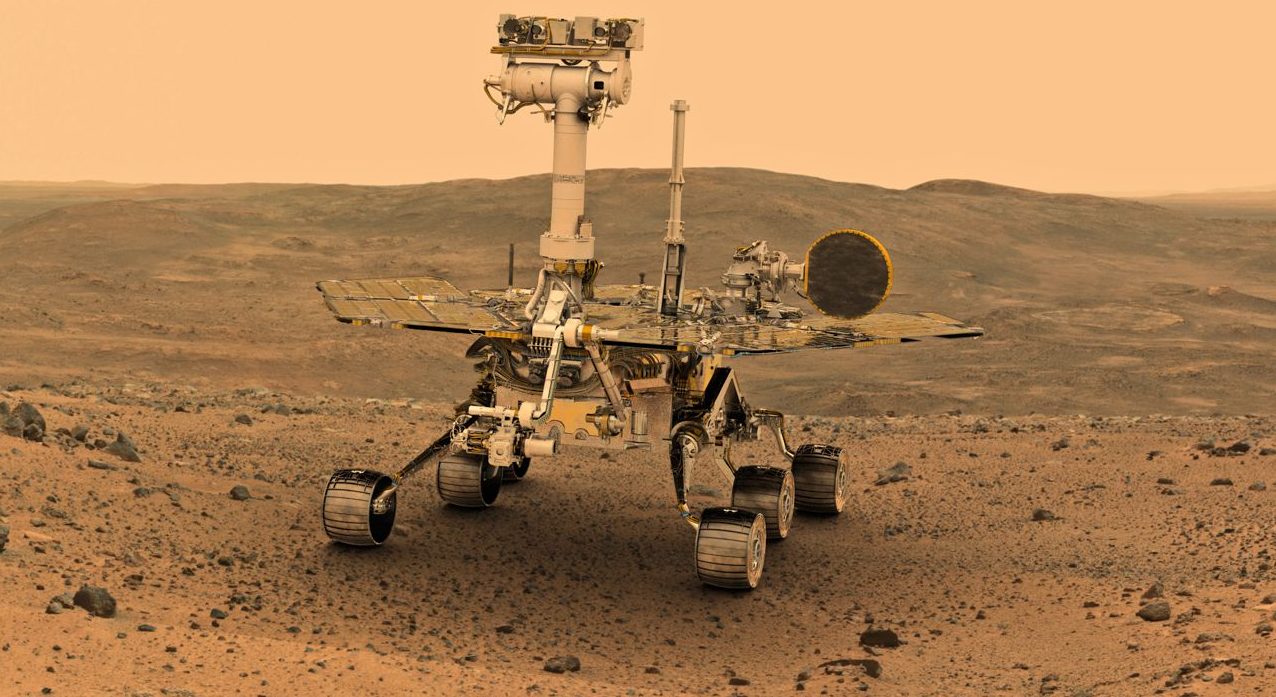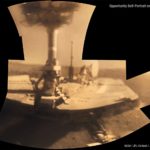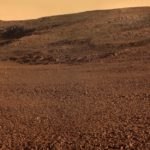

News
Massive storm on Mars downs NASA’s Opportunity Rover after 14 years on the red planet
NASA recently held a press conference about the current status of the Opportunity Rover (or Oppy, as it is fondly called), which is weathering a massive storm covering a quarter of the Red Planet’s surface. According to NASA, communication with Opportunity remains down as of date, though the space agency is optimistic that the 14-year-old rover can still make it through the storm.
The massive storm currently affecting Mars covers 15.8 million square miles (41 million square kilometers), which is roughly the size of North America and Russia combined. The intensity of the storm has effectively blocked the sunlight on Mars’ surface, preventing Opportunity to charge its batteries. The rover is currently near the center of the storm, inside the Red Planet’s Perseverance Valley. NASA is under the assumption that Opportunity’s batteries have dipped below 24 volts, causing the machine to enter low power fault mode. In this state, all of Opportunity’s subsystems except its mission clock are turned off. During NASA’s press conference, John Callas, Opportunity’s project manager, stated that the rover’s present state invokes concern.
“The analogy I would use right now is it’s like you have a loved one in a coma in the hospital. The doctors are telling you that you’ve just got to give it time and she’ll wake up, all the vital signs are good, so it’s just waiting it out — but you know, if it’s your 97-year-old grandmother you’re going to be very concerned. And we are. By no means are we out of the woods here,” he said.
Opportunity has been on the Red Planet for close to 15 years, far more than the duration of its original 90-day mission. As of January 2018, the rover has managed to cover a distance of 45.09 kilometers (28.02 miles), studying Mars’ terrain and laying the foundations for missions to come. Opportunity was sent to the Red Planet with its sister rover, Spirit. While both machines were able to last far beyond their initial 90-day mission, Spirit ultimately fell silent in 2010, six years into its exploration of the Martian landscape.
Overall, it would be truly sad to lose Opportunity after such a long and storied life, but the near future will be filled with many new robotic Martians striving to uncover the Red Planet’s mysteries. After all, Opportunity, as well as Spirit and the larger, nuclear-powered Curiosity rover (which is also experiencing reduced solar energy due to the massive storm), have all but laid the foundations for further and more ambitious missions on the Red Planet. Plans are already underway to develop and launch Mars 2020, a rover based on Curiosity, and ExoMars, a rover from Europe — both of which would be tasked to find signs of life. Mars Insight, a robotic lander designed to study the interior of the Red Planet, has also been launched last May and is expected to land sometime in November.
Despite the challenge facing Opportunity right now, however, Jim Watzin, the director of NASA’s Mars Exploration Program, stated that NASA is still hoping the nearly 15-year-old rover will somehow survive.
“We’re all pulling for Opportunity. As you know, it’s been a remarkably resilient rover, lasting 15 years — well beyond its original design life of just 90 days. Its longevity has taught us much about operating on the surface of Mars. But regardless of how this turns out, this little rover has proven to be an invaluable investment that has greatly increased our ability to explore the Red Planet,” he said.

Elon Musk
Elon Musk and Tesla AI Director share insights after empty driver seat Robotaxi rides
The executives’ unoccupied tests hint at the rapid progress of Tesla’s unsupervised Robotaxi efforts.

Tesla CEO Elon Musk and AI Director Ashok Elluswamy celebrated Christmas Eve by sharing personal experiences with Robotaxi vehicles that had no safety monitor or occupant in the driver’s seat. Musk described the system’s “perfect driving” around Austin, while Elluswamy posted video from the back seat, calling it “an amazing experience.”
The executives’ unoccupied tests hint at the rapid progress of Tesla’s unsupervised Robotaxi efforts.
Elon and Ashok’s firsthand Robotaxi insights
Prior to Musk and the Tesla AI Director’s posts, sightings of unmanned Teslas navigating public roads were widely shared on social media. One such vehicle was spotted in Austin, Texas, which Elon Musk acknowleged by stating that “Testing is underway with no occupants in the car.”
Based on his Christmas Eve post, Musk seemed to have tested an unmanned Tesla himself. “A Tesla with no safety monitor in the car and me sitting in the passenger seat took me all around Austin on Sunday with perfect driving,” Musk wrote in his post.
Elluswamy responded with a 2-minute video showing himself in the rear of an unmanned Tesla. The video featured the vehicle’s empty front seats, as well as its smooth handling through real-world traffic. He captioned his video with the words, “It’s an amazing experience!”
Towards Unsupervised operations
During an xAI Hackathon earlier this month, Elon Musk mentioned that Tesla owed be removing Safety Monitors from its Robotaxis in Austin in just three weeks. “Unsupervised is pretty much solved at this point. So there will be Tesla Robotaxis operating in Austin with no one in them. Not even anyone in the passenger seat in about three weeks,” he said. Musk echoed similar estimates at the 2025 Annual Shareholder Meeting and the Q3 2025 earnings call.
Considering the insights that were posted Musk and Elluswamy, it does appear that Tesla is working hard towards operating its Robotaxis with no safety monitors. This is quite impressive considering that the service was launched just earlier this year.
Elon Musk
Starlink passes 9 million active customers just weeks after hitting 8 million
The milestone highlights the accelerating growth of Starlink, which has now been adding over 20,000 new users per day.

SpaceX’s Starlink satellite internet service has continued its rapid global expansion, surpassing 9 million active customers just weeks after crossing the 8 million mark.
The milestone highlights the accelerating growth of Starlink, which has now been adding over 20,000 new users per day.
9 million customers
In a post on X, SpaceX stated that Starlink now serves over 9 million active users across 155 countries, territories, and markets. The company reached 8 million customers in early November, meaning it added roughly 1 million subscribers in under seven weeks, or about 21,275 new users on average per day.
“Starlink is connecting more than 9M active customers with high-speed internet across 155 countries, territories, and many other markets,” Starlink wrote in a post on its official X account. SpaceX President Gwynne Shotwell also celebrated the milestone on X. “A huge thank you to all of our customers and congrats to the Starlink team for such an incredible product,” she wrote.
That growth rate reflects both rising demand for broadband in underserved regions and Starlink’s expanding satellite constellation, which now includes more than 9,000 low-Earth-orbit satellites designed to deliver high-speed, low-latency internet worldwide.
Starlink’s momentum
Starlink’s momentum has been building up. SpaceX reported 4.6 million Starlink customers in December 2024, followed by 7 million by August 2025, and 8 million customers in November. Independent data also suggests Starlink usage is rising sharply, with Cloudflare reporting that global web traffic from Starlink users more than doubled in 2025, as noted in an Insider report.
Starlink’s momentum is increasingly tied to SpaceX’s broader financial outlook. Elon Musk has said the satellite network is “by far” the company’s largest revenue driver, and reports suggest SpaceX may be positioning itself for an initial public offering as soon as next year, with valuations estimated as high as $1.5 trillion. Musk has also suggested in the past that Starlink could have its own IPO in the future.
News
NVIDIA Director of Robotics: Tesla FSD v14 is the first AI to pass the “Physical Turing Test”
After testing FSD v14, Fan stated that his experience with FSD felt magical at first, but it soon started to feel like a routine.

NVIDIA Director of Robotics Jim Fan has praised Tesla’s Full Self-Driving (Supervised) v14 as the first AI to pass what he described as a “Physical Turing Test.”
After testing FSD v14, Fan stated that his experience with FSD felt magical at first, but it soon started to feel like a routine. And just like smartphones today, removing it now would “actively hurt.”
Jim Fan’s hands-on FSD v14 impressions
Fan, a leading researcher in embodied AI who is currently solving Physical AI at NVIDIA and spearheading the company’s Project GR00T initiative, noted that he actually was late to the Tesla game. He was, however, one of the first to try out FSD v14.
“I was very late to own a Tesla but among the earliest to try out FSD v14. It’s perhaps the first time I experience an AI that passes the Physical Turing Test: after a long day at work, you press a button, lay back, and couldn’t tell if a neural net or a human drove you home,” Fan wrote in a post on X.
Fan added: “Despite knowing exactly how robot learning works, I still find it magical watching the steering wheel turn by itself. First it feels surreal, next it becomes routine. Then, like the smartphone, taking it away actively hurts. This is how humanity gets rewired and glued to god-like technologies.”
The Physical Turing Test
The original Turing Test was conceived by Alan Turing in 1950, and it was aimed at determining if a machine could exhibit behavior that is equivalent to or indistinguishable from a human. By focusing on text-based conversations, the original Turing Test set a high bar for natural language processing and machine learning.
This test has been passed by today’s large language models. However, the capability to converse in a humanlike manner is a completely different challenge from performing real-world problem-solving or physical interactions. Thus, Fan introduced the Physical Turing Test, which challenges AI systems to demonstrate intelligence through physical actions.
Based on Fan’s comments, Tesla has demonstrated these intelligent physical actions with FSD v14. Elon Musk agreed with the NVIDIA executive, stating in a post on X that with FSD v14, “you can sense the sentience maturing.” Musk also praised Tesla AI, calling it the best “real-world AI” today.











